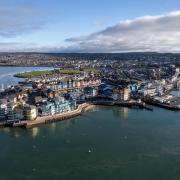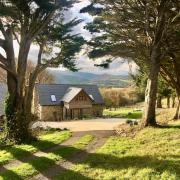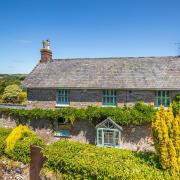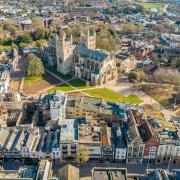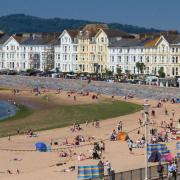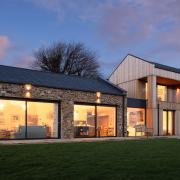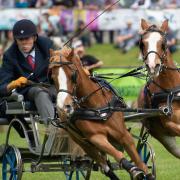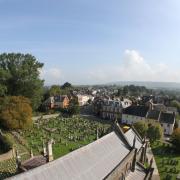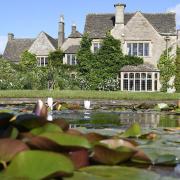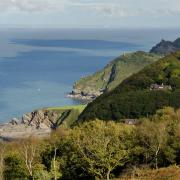With its mix of formality and wilderness, set against the backdrop of Exeter Cathedral, ANNE BRUNNER-ELLIS discovers the delights of the Bishop’s Palace Garden

The Bishop’s Palace is the official residence of the Right Revd Robert Atwell, Bishop of Exeter. Whilst numerous functions are held within the Palace and its garden, it remains a home and is not normally open to the public.
Recently, however, at the suggestion of the Bishop, the Cathedral has extended its official tours to include the Lady Chapel and the Bishop’s Palace Garden.
“The Bishop particularly wanted the public to be able to enjoy the garden,” explained his executive assistant, Justine Tear.
From the hustle and bustle of the city, through the 14th-century gateway, you are led into a world of peace and tranquility.

The garden stands among lawns and shrubs which were principally laid out during the 18th century and over the years successive Bishops have made their personal marks.
Trees are an important feature and on entering the grounds the first view is of one of the finest examples of a first generation Lucombe Oak – an evergreen cross between a Turkey Oak and a Cork Oak, bred by William Lucombe in Exeter more than 200 years ago.
Many of the large trees were planted in the 1880s by Bishop Bickersteth, including the horse chestnut and copper beech whose bare branches in winter set against a frosty blue sky are spectacular.
Look out for the large Spanish Chestnut Tree with its knarled and furrowed bark and great base which has a remarkable resemblance to an elephant’s foot. There are impressive herbaceous borders.

Bishop Robert’s favourite is the blue and white bed on the east wall of the Palace. With roses, michaelemas daisies, scented stocks and sedum it is a joy to behold.
He is a keen horticulturist and works closely with James, the gardener, to ensure that they plant the right plant for the right place.
In the 1980s, along its southern edge, Joy Thompson, wife of Bishop Hewlett, planted a wild garden – well before these became popular.
The best time to view this is in spring with its fritillaries, cowslip and teazles which remind us of Devon’s historic wool trade.

“With its wealth of flowers from spring through to summer, it remains my favourite area of the garden,” comments James.
The level gravel path around the garden makes the tour easier for those with limited mobility.
The eastern edge is bound by the old Roman bank and city wall.
Halfway along you will find a 17th-century door and passageway which Bishop Carey built into the medieval bastion to allow him to leave the garden without passing through the city.

Whilst still passable the passage today is used more by bats and other wildlife – the garden is home to foxes, badgers and numerous squirrels.
It is not just horticulture that visitors can enjoy. Of interest are the numerous sculptures which have been added to the garden over the years.
The boldest is the large Trinity sculpture. Carved from Beer stone by Frances Ma-Favata it was commissioned by the Bishop Hewlett and his wife in the 1990s.
The work is a group comprising two men and one woman. The father is seen as holding, the son receives the spirit of the female who is giving, with her hands outstretched. Set against the backdrop of the garden and the cathedral, visitors are encouraged to walk amongst them and enjoy their enormity.

Not everyone appreciates modern sculpture, but they add a grandeur and discussion point to the garden.
Another commissioned by Bishop Hewlett is Cyclus. Carved by Axel Ewald from York stone, it represents the unfolding of the seasons. Recently Bishop Robert has grown a yew hedge around three sides of the sculpture to enclose it for more personal contemplation.
Hidden within the flowing lines of the Spanish chestnut tree in a split in the bark can be found a small face. Carved by Bishop Eric Mercer in the 1980s, it is a portrait of his wife, Rosemary.
The most recent addition, next to the Catalpa tree planted by Bishop Robert, is a flame shaped carved stone inscribed with the first line from Gerald Manley Hopkins’ poem God’s Grandeur’. Originally in the Bishop’s previous garden is Stockport, it has now been moved to Exeter where it fits like a glove.
Whilst the Palace can be dated to 1224, the early history of the garden is not recorded. However, it is thought the garden is one of the oldest in Devon.
In medieval times this was not only the Palace where the Bishop and his household lived, but also a garden for growing produce for the household, a butchery, chickens and cows, a blacksmith, stables and more.
Amidst all this the garden has always been a place of prayer and contemplation, as it is today.
https://www.exeter-cathedral.org.uk/
LADY CHAPEL AND BISHOP PALACE GARDEN TOUR
A journey through time starting from the earliest days of the building of the Medieval Gothic Cathedral, looking around the Lady Chapel from inside and out, hearing a tale of political murder and ending up in the private gardens of the Bishop of Exeter.
The tour includes views of the exteriors of the Bishop’s Palace and the Lady Chapel which can only be seen from the private gardens of the Bishop (not normally open to the public).
Weekly, 11.00, Wednesdays. 90 minutes. £14 adults, £12 Seniors/Students, £6 Children 6-18



